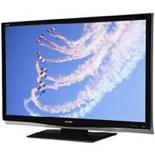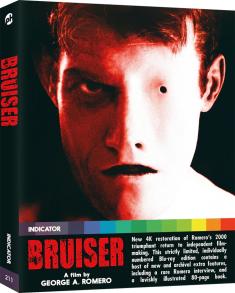Sharp LC-37D64U LCD HDTV
Overview -This article has been abridged and updated from an original review on HDD's sister-site www.AVRev.com
IntroductionSharp has added 32- and 37-inch models, both with a 1080p resolution. The LC-37D64U’s $1,499.99 asking price puts it under Sharp’s new high-end gaming series, but that 1080p resolution still carries a price premium over the company’s similarly-sized 768p models. As I sat down to review this TV, the first question that came to my mind was, do you really need to pay more for 1080p on a 37-inch screen?
Set-upThe Slim-line moniker refers to the TV’s sleeker cabinet design, which is 25 percent slimmer and 20 percent lighter than previous Sharp LCDs. The attractive gloss-black bezel measures about one-and-a-half inches to the top and sides and about two inches at the bottom; a slim, silver speaker bar runs along the bottom panel, recessed slightly behind the main bezel. Indeed, the LC-37D64U’s smaller footprint was partly responsible for my “little” reaction, described above. My 2006 HP MediaSmart LCD also has a 37-inch screen, and it barely fits in a large cabinet in my bedroom. It also requires two people to move it from one place to another, due primarily to its bulk. This Sharp, on the other hand, fits easily in said cabinet, and I can carry it myself. On its own, the TV weighs a little over 38 pounds and measures three-and-three-quarters inches deep. The LC-37D64U arrives with the stand detached – which makes sense, as this TV’s lighter weight makes wall-mounting a more realistic option. Attaching the stand was a simple process that took only a few minutes. On its own, the plastic stand feels a little flimsy, weighing only about seven pounds, but it holds the LCD securely in place and compliments the TV visually.
The Sharp’s input panel is solid but not as generous as that of competitors that offer four HDMI inputs and peripheral features like Ethernet connectivity and music/photo playback through a USB port or card slot. The LC-37D64U has just two HDMI inputs, neither of which is located on the front or side panel. The side panel does sport one component video input, along with a set of basic A/V inputs and a USB port for service only. In addition to the two HDMIs on back, you’ll find one component video, one D-Sub 15-pin PC, one S-video, two composite video and one RF input for accessing the internal ATSC/NTSC/Clear-QAM tuners. The HDMI inputs accept both 1080p/60 and 1080p/24, and the component video inputs accept 1080p/60, which is less common. Optical digital and stereo analog audio outputs are included, as is an RS-232 control port.
The onscreen menu has an intuitive layout that I found easy to navigate. The main categories (Picture, Audio, Power Control, Set-up, Option and Digital Set-up) run horizontally across the screen, while the sub-menu items run vertically beneath them. My only gripe is that the Picture sub-menu doesn’t minimize when you make adjustments to the video parameters; even though the menu is translucent, it’s still a bit challenging to adjust color and tint in particular. The remote has a clean, smart button layout, and the inclusion of exit and return buttons makes menu navigation all the easier. It lacks dedicated source buttons, but it does sport partial backlighting, including desired buttons like input, volume, channel, mute and menu. Seven buttons hide behind a panel at the bottom of the remote, including an AV Mode button that lets you scroll between the TV’s seven picture modes: Dynamic (Fixed), Dynamic, Standard, Movie, Game, PC and User. Strangely, you can’t select an AV Mode directly via the onscreen menu; you can only scroll one way through the seven options via the remote, which is cumbersome. As usual, the Dynamic picture modes are to be avoided, as they are exaggerated and inaccurate. I stuck with the tried-and-true Movie mode, but the Standard mode is also a good base for a brighter viewing environment.
The LC-37D64U offers a solid amount of image adjustments, but it lacks some higher-end refinements that the enthusiast would appreciate. For one, you can’t configure each AV Mode differently for each input. In terms of the basic contrast, brightness, color, tint and sharpness controls, it’s worth noting that, if you set the contrast too high, it crushes whites, robbing them of fine detail. Edge enhancement is a concern at the higher sharpness settings, while softness is a concern at the lower settings; it’s best to stay near the default middle sharpness setting through both the HDMI and component inputs. The LC-37D64U sports a 33-step adjustable backlight, as well as an automatic brightness adjustment called OPC, which uses a light sensor on the TV’s front panel to adjust image brightness based on room lighting. You can set the high and low range of the OPC adjustment or turn it off completely; I chose the latter and went with the fixed backlight control instead. I also turned off the Active Contrast setting that automatically adjusts contrast based on image content. Two settings dictate how the TV handles interlaced 480i and 1080i sources: Film mode (on/off) detects the 3:2 sequence in film-based sources, and I/P Setting lets you designate whether content is fast or slow. The TV has a solid array of color adjustments, including five color-temperature options (high, mid-high, middle, mid-low and low) and a color management system that lets you precisely adjust the hue and saturation of the primary and secondary color points. However, the menu lacks the advanced gamma and white-balance controls you’ll find in some comparably-priced LCDs. You do get a basic noise-reduction control (off/low/high) that’s oddly located in the Option menu instead of the Picture menu.
The Audio set-up menu contains your run-of-the-mill treble, bass and balance adjustments, plus a generic bass enhancer and surround on/off mode. Again, this TV lacks more advanced options like preset audio modes, SRS processing and a sound stabilizer to minimize volume jumps between TV shows and commercials. The set-up menu is where you can configure the RF input for analog and/or digital channels and launch the tuning process. The switch is fairly quick, but doesn’t provide much information beyond the overall number of analog and digital stations tuned. Deleting unwanted channels and selecting favorites is a bit more tedious than it needs to be, and the menu doesn’t include a program guide. The omission of picture-in-picture is becoming increasingly common on newer HDTVs, and Sharp has opted to follow suit. Aspect-ratio options are limited to four for both 4:3 and 16:9 programming; there’s no mode to reshape incorrectly stretched 4:3 programs on HD channels, but there is a Dot by Dot mode for showing 1080i/1080p with no overscan. As was the case with the AV Mode function, you can’t switch aspect ratios via the onscreen menu; you can only do so via the remote’s View Mode button.
Television and MoviesLCD manufacturers have been somewhat slow to offer 1080p in their 37-inch and smaller TVs. That’s because the benefits of this are questionable, at least from a detail standpoint. The common argument is that, at a normal viewing distance, your eye probably can’t discern the difference in detail between 720p and 1080p. Since part of the LC-37D64U’s higher price tag is owed to its 1080p designation, I decided to begin my evaluation by looking specifically at resolution. With both Blu-ray discs and HDTV shows, the Sharp image was consistently crisp and razor-sharp, and the up-conversion of standard-def DVD and TV signals was also better than average. In a direct comparison with my reference Panasonic 42-inch 1080p plasma, the LC-37D64U did a slightly better job rendering fine detail; admittedly, it does have a smaller screen. The comparison I was most curious about was between the LC-37D64U and the aforementioned HP MediaSmart LCD, also 37 inches but with a 1366 x 768 resolution (and let’s just say that the TV is “heavily influenced” by Sharp technology). Since the older HP doesn’t accept 1080p, I used Blu-ray test scenes from Black Hawk Down (Sony Pictures Home Entertainment), The Corpse Bride (Buena Vista Home Entertainment) and Pirates of the Caribbean: The Curse of the Black Pearl (Buena Vista Home Entertainment), output at 720p and 1080i. I was able to discern some improvement in detail with the LC-37D64U at a distance of about six feet. Hard edges looked just a little sharper, and facial pores and hairs were more defined. Six feet is closer than you think, though. If you put this TV in a bedroom or very small living room, you might sit that close. Once I moved back to about 10 feet, those subtle differences became hard to discern.
Detail is just one aspect of performance, though. In many other respects, the new Sharp showed clear improvement over the older LCD model, no matter the viewing distance. Its black level, black detail and overall contrast ratio were much better, creating a richer, more engaging image. The LC-37D64U’s blacks weren’t quite as deep as those of the Panasonic plasma or the best LCDs I’ve reviewed. The night skies of The Bourne Supremacy DVD (Universal Studios Home Video) and Black Pearl Blu-ray discs were closer to dark gray than black. In all, the image retains solid saturation in a completely dark room, but it doesn’t have that extra level of richness and three-dimensionality that characterizes the best high-end panels. This LCD is capable of great light output, giving it a clear advantage over the plasma TV in a bright room; fine details that were lost on the Panasonic, because of screen glare, were still perfectly visible on the LCD and brighter HDTV shows looked very engaging during the day.
The LC-37D64U offers natural color points for a flat panel, and skin tones were consistently neutral. The island greens of Lost on ABC HD looked more realistic and less electric than they did on my reference plasma and projector. Initially, the reds in ESPN’s scroll bar were a bit too magenta, but I easily remedied this by adjusting the red hue via the color management system, which also lets you add more saturation to colors if you prefer. The LC-37D64U’s picture is not hindered by digital noise, which allows you to sit closer without being distracted by excessively noisy backgrounds or uneven light-to-dark transitions. Nevertheless, I experimented with the noise-reduction settings: The high setting will reduce what little noise there is, but it creates that distracting trailing/lag effect with darker signals. The low setting is a better choice.
I encountered an inexplicable discrepancy when trying to evaluate the TV’s de-interlacing through both the HDMI and component video inputs. When I output 480i and 1080i signals from a Sony BDP-S300 Blu-ray player, the LC-37D64U passed all of my de-interlacing tests, creating a generally clean image with few digital artifacts. However, with a Pioneer BDP-95FD Blu-ray player and Sony DVP-NS75H DVD player, the LC-37D64U failed the same tests, creating a lot of jaggies in my Gladiator DVD (DreamWorks Home Entertainment) test and blatant moiré in my Mission: Impossible III Blu-ray test (Paramount Home Entertainment). I’m at a loss to explain why this would occur, since the same TV is handling the de-interlacing in each case. In any event, the fact that the LC-37D64U failed with two players and passed with one gives cause for concern. The 1080i performance was generally better across the players, but I still recommend you mate this TV with a Blu-ray or DVD player that has good internal processing of its own. The fact that the TV accepts 1080p/60 and 1080p/24 through HDMI, and has a Dot by Dot aspect ratio with zero overscan, means that you can enjoy native 1080p signals from a Blu-ray player with minimal or no processing required on the TV’s part – that is one clear benefit of a 1080p display of any screen size. As for TV signals, I didn’t observe artifacts with 1080i TV shows, but I did see some tearing and jaggies in a 480i broadcast of Big on AMC, as well as an episode of Scrubs on Comedy Central, when I sat fairly close to the screen; however, at a 10-foot viewing distance, these digital artifacts were difficult to discern on such a small screen.
The DownsideGiven that the LC-37D64U has five color temperatures to choose from, I’m disappointed that Sharp didn’t include one warm option for those enthusiasts who want something close to 6,500 Kelvin. Even the low color temp setting is overly cool (or blue), particularly with darker content. Both the nighttime skies and the white snow of The Corpse Bride’s chapter five contained too much blue, as did the dimly lit grays that so often permeate C.S.I. on CBS HD. The Sharp’s color temp isn’t excessively inaccurate, but I personally prefer a warmer tone, as I find that it makes the image look fuller and more inviting. Cool tones tend to flatten everything out. This TV lacks user-accessible white-balance controls and can’t be professionally calibrated, so there’s way to address this concern.
The LC-37D64U also exhibits some common LCD performance issues. Its viewing angle is not terribly wide; even at 45 degrees off-axis, image saturation falls off fairly significantly. The picture is certainly watchable at wide angles, but you lose the benefits gained by the better black level and contrast ratio you get straight on. This TV does not use 120Hz or other technology to address motion blur; it does have a 6ms response time, but I saw a clear loss of detail in faster-moving content, both with test patterns from my FPD Software Group Blu-ray disc and with real-world high-def hockey/basketball games. Motion blur is less obvious on a smaller screen, but again, it ties into the resolution-vs.-price debate.
The most troublesome issue with the LC-37D64U is a blatant brightness uniformity problem in which the left and right sides of the screen are clearly brighter than the middle. This was evident with white and black test patterns, but was especially pronounced with gray. As such, in my Ladder 49 DVD, where gray smoke hangs over the scene in chapter 10, the screen’s brighter edges were very noticeable; it was like I was watching a dream sequence with hazy edges. With 1.85:1 or 2.35:1 DVD content that contains black bars, the left side of the bars was clearly brighter than the middle or right. This was less of a concern with brighter HDTV content, but it was at times very distracting with darker DVD and Blu-ray movies.
Finally, don’t expect much fullness or bass from the tiny speaker bar that runs along the bottom of the TV. Not surprisingly, the audio quality is fairly thin and treble-heavy, and dynamic ability is not outstanding. You’ll get better results by adding an outboard audio system.
ConclusionThe LC-37D64U excels at rendering a bright, colorful and extremely detailed image in a daytime viewing environment. HDTV looks great, which makes this an especially good fit for the TV lover who will use it primarily for daily HDTV and SDTV viewing, but would also like to enjoy a nice-looking DVD or Blu-ray movie from time to time.
While I saw some advantages to 1080p at this screen size, I’m still not entirely convinced you need it – particularly when there are so many 37-inch, 768p models priced under $1,000. Sharp’s own LC-37D44U is available for under $900 through reputable online retailers, and its specs are otherwise similar to those of the D64U. If price isn’t a major concern for you, then I say go for 1080p. But, if a couple hundred dollars in savings is a big deal, it’s okay to step down to 768p. It’s still high-def and can still look fantastic, no matter what the salesperson tries to tell you on the retail floor.












